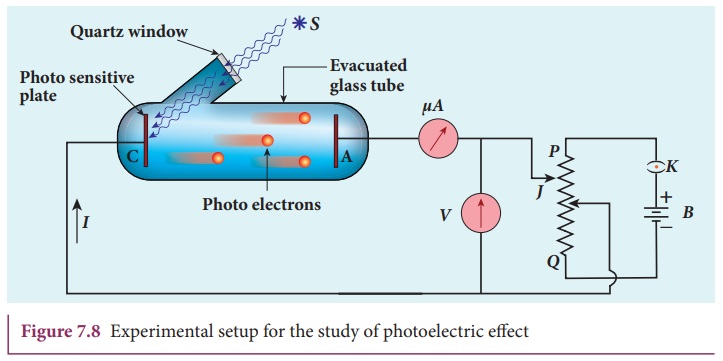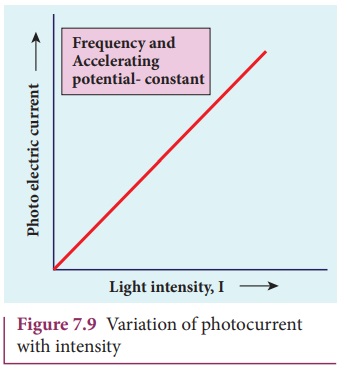Photo Electric Effect | Physics - Effect of intensity of incident light on photoelectric current | 12th Physics : UNIT 8 : Dual Nature of Radiation and Matter
Chapter: 12th Physics : UNIT 8 : Dual Nature of Radiation and Matter
Effect of intensity of incident light on photoelectric current
Effect of intensity of incident light on
photoelectric current
Experimental setup
The apparatus shown in Figure 7.8 is
employed to study the phenomenon of photoelectric effect in detail. S is a source of electromagnetic waves
of known and variable frequency ν and
intensity I. C is the cathode (negative electrode) made up of photosensitive
material and is used to emit electrons. The anode (positive electrode) A collects the electrons emitted from C. These electrodes are taken in an
evacuated glass envelope with a quartz window that permits the passage of
ultraviolet and visible light.
The necessary potential
difference between C and A is provided by high tension battery B which is connected across a potential
divider arrangement PQ through a key K. C
is connected to the centre terminal while A to the sliding contact J of
the potential divider. The plate A can
be maintained at a desired positive or negative potential with respect to C. To measure both positive and negative
potential of A with respect to C, the voltmeter is designed to have its
zero marking at the centre and is connected between A and C. The current is
measured by a micro ammeter ÎĽA in
series.

If there is no light falling on the cathode C, no photoelectrons are emitted and the microammeter reads zero. When ultraviolet or visible light is allowed to fall on C, the photoelectrons are liberated and are attracted towards anode. As a result, the photoelectric current is set up in the circuit which is measured using micro ammeter.
The variation of photocurrent with
respect to (i) intensity of incident light (ii)
the potential difference between the electrodes (iii) the nature of the
material and (iv) frequency of incident light can be studied with the help of
this apparatus.
Effect of intensity of incident light on photoelectric current
To study the effect of intensity of
incident light on photoelectric current, the frequency of the incident light
and the accelerating potential V of
the anode are kept constant. Here the potential of A is kept positive with respect to that of C so that the electrons emitted from C are attracted towards A.
Now, the intensity of the incident light is varied and the corresponding
photoelectric current is measured.

A graph is drawn between light
intensity along x-axis and the photocurrent along y-axis. From the graph in
Figure 7.9, it is evident that photocurrent
– the number of electrons emitted per second – is directly proportional to the
intensity of the incident light.
Here, intensity of light means brightness. A bright light has more intensity than a dim light.
Related Topics